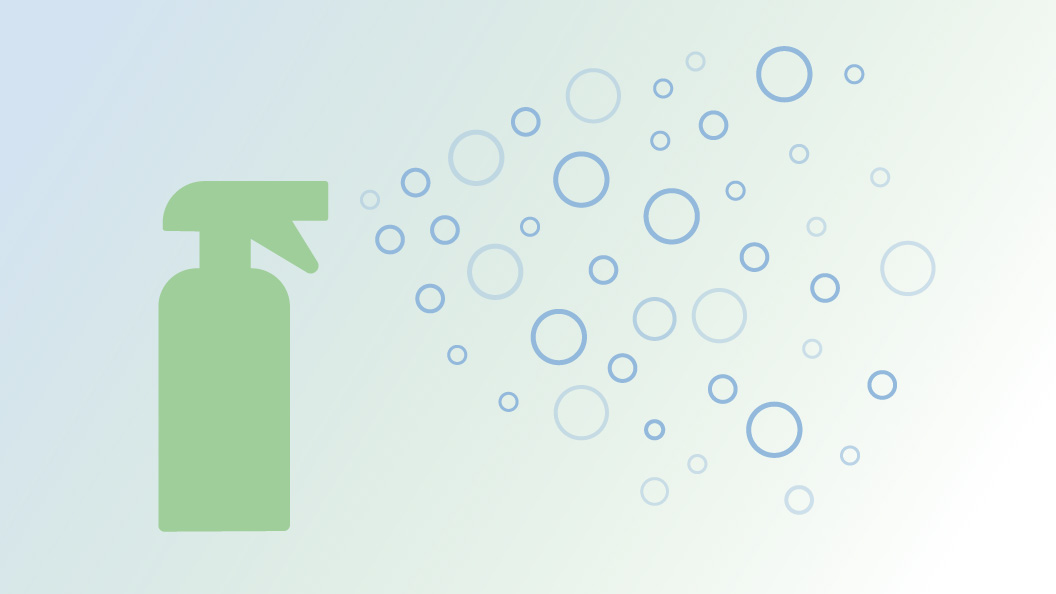
26.04.23
Smells – our perception of smell and how we can influence it
An odor is caused by one or more volatilized chemical compounds, generally present in low concentrations. Depending on the perception, the odor is called "scent" or "stench". We can influence odors by chemically or enzymatically transforming the chemical compounds or by reducing their concentration in the air by physically binding them in or to a medium. Furthermore, it is also possible to mask bad odors with pleasant odors (in the form of a perfume or fragrance).

Summary
An odor is described as a signal caused by one or more volatilized chemical compounds, which are generally present in low concentrations in the air as a so-called volatile substance or simplified as VOC (volatile organic compound).
An odor signal is an individual interpretation of sensory excitation, which in mammals is transmitted by chemical receptors in the nasal region as an electrochemical signal to the brain of a higher living being.
Basically, odor can be described as a signal generated by volatile chemical messengers, which induces a signal and followed by an emotion in a living being through a form of a molecular receptor.
In mammals, odorants enter the nasal region through the air when inhaled and come into contact with the olfactory mucosa and its receptors. Dissolved odor molecules bind to a wide variety of odor receptor types, each of which responds to only one group of odor molecule types. The combination of electrochemical signals from the odorant or a mixture of odorants is perceived by the brain or sensory organ as odor, odor perception, or sensory stimulus.
On the one hand, odor perception is genetically determined – type, number and affinity of the receptors as well as their linkages – and can be or is learned as a perceptual process by the brain, e.g. through its social and cultural environment.
What is smell?
An odor is caused by one or more volatilized chemical compounds, generally present in low concentrations. Most odors consist of simple and rather small organic or carbon-containing compounds. However, some simple odorants do not contain carbon, such as hydrogen sulfide and ammonia.
Humans and many animals can detect volatile compounds through their sense of smell with varying intensity and interpretation. An odor is also referred to as a “scent” or “stink,” which refers to either a pleasant or unpleasant perception of the odor.
How are odors created?
Volatile chemical compounds – potential sources of both good and bad odors – can be formed by chemical-biological degradation, conversion or build-up from non-smelling substances. This transformation can be biological or purely chemical.
In addition to often malodorous metabolic degradation products – such as putrefaction and decomposition – nature also intentionally produces chemical substances as scents and attractants. Incomplete chemical reactions or unintended side reactions can also result in unintended odorous substances. The origin and effect of odor molecules are extremely versatile.
| Degradation of matter by processes (Mass degradation of the carrier material, biological & chemical processes) | Chemical or biological odor molecules through the air (odor produced elsewhere by humans, environment, fungi or plants) |
| Odor products that are independent of the carrier (e.g. metabolism: ammonia, acetic acid, fatty acid derivatives, etc.) | Uptake and free release of volatile odor molecules (e.g. VOC, solvents or polymer components, recycling) |
According to the model envisioned in the figure above, odors can arise or have origins through various pathways and processes.
Top left: During the degradation of matter or a carrier material, e.g., polymer, wood, or even an apple, odor molecules can be created by odor molecules. These degradation processes can be chemical, e.g. oxidation processes, or biological (decay by fungi in the forest) and result in a loss of mass of the original matter.
Bottom left: Due to a deposition or contamination of mostly organic nature, e.g., deposit or biodeposit, odors can again be chemical or biological in nature, independent of the carrier. Examples are the over-smelling sauce splash decomposing by bacteria or when the spaghetti sauce decomposes chemically-physically on the stove by heating. Another typical example is the decomposition of organic matter by anaerobic bacteria into bad odors in places like sewers.
Bottom right: Any surface can adsorb or absorb odorants and release them at a later time or changed physical conditions, e.g. temperature. Classic examples are solvents (often VOCs) or components of polymers, which are re- or released by heat or migration. Odor adsorbers also work on a similar principle, as long as the odor molecules do not chemically react with the surface.
Top right: Odor molecules can also be transported from elsewhere by air circulation and have something to do only indirectly with the local matter, surface, contamination or biology. Examples are the rapeseed field next door, the over-smelling sewage plant, a burning car tire or the bad body odor – despite shower – due to the malodorous garment.
How are odors perceived and interpreted?
In higher organisms, the perception of odors or the sense of smell is mediated by the olfactory nerve. Olfactory receptor (OR) cells are neurons present in the olfactory epithelium, a small patch of tissue at the back of the nasal cavity. In general, there are millions of olfactory receptor neurons that function as sensory signaling cells. Again, each neuron has cilia in direct contact with the air. Dissolved odor molecules bind to receptor proteins extending on the cilia and act as a chemical stimulus that initiates electrical signals that travel along the axons of the olfactory nerve to the brain.
When an electrical signal exceeds a threshold, the neuron relays a signal along the axon to the olfactory bulb, a part of the brain’s limbic system. There, the interpretation of the odor begins by relating the received olfactory signal to past experiences and in relation to the inhaled substance(s). The olfactory bulb acts as a connecting station, linking the nose to the olfactory cortex in the brain. Olfactory information is further processed and transmitted to the central nervous system (CNS). The CNS controls emotions and behavior, as well as basic thought processes, which are triggered by the olfactory stimulus. Olfactory sensation usually depends on the concentration (number of molecules) available to olfactory receptors. A single odorant is usually detected by many receptors. Different odorants are in turn detected by combinations of receptors. The patterns of neuronal signals and historical association with past odor events help identify the odor. The olfactory olfactory system interprets not a single compound, but the entire mixture of the odor. This does not correspond to the simple concentration or intensity of a particular single compound.
In summary, the perception of an olfactory effect is a two-stage process. On the one hand, there is the physiological part. This is the detection of stimuli by receptors in the nose. After that, the stimuli are recognized by the region of the human brain that deals with the sense of smell and interpreted according to personal experience. For this reason, a personal or objective and analytical measurement of odor is impossible. Smell sensations are personal perceptions. Individual reactions to them are usually culturally trained and conditioned by factors such as gender, age, state of health, or cultural and personal environment.
What can be done about “bad odors”?
At the origin of odors are volatile chemical compounds of various origins. On the one hand, these chemical compounds can be converted chemically or enzymatically, or their concentration in the air can be reduced by physical bonding in or on a medium. Furthermore, it is also possible to mask bad odors with pleasant odors (in the form of a perfume or fragrance).
According to the figure above, there are different, but also similar, treatment concepts depending on the origin of the odor:
Top left: Odors caused by mass degradation of matter – by biological and/or chemical processes – can be prevented or reduced differently depending on their origin. Protection against chemical-physical degradation such as temperature, UV light, etc. can be achieved to a certain extent by chemical stabilizers, e.g. UV stabilizers, or protection of matter against negative physical influences, e.g. flame retardants. Biodegradation and odor can be achieved by adding germicidal biocidal substances to the matter – these migrate to the surface – or by disinfecting the surface (surface disinfection) or even by reducing microbial contamination in the matter (preservation).
Bottom left: Odor-causing deposits or contamination – usually organic in nature, e.g., biodeposits or chemically transformed deposits, can be relatively easily prevented by cleaning (deposits and biodeposits) and disinfection (biodeposits) or removed or reduced by chemical transformation, e.g., chemical oxidation, followed by cleaning.
Bottom right: Odor molecules bound to or in matter can be reduced by odor adsorbers (surface) or odor absorbers (into matter). In turn, purification or chemical modification of the attached or bound odor molecules is effective.
Top right: Chemical or biological odor molecules that pass through the air to the nose are generally somewhat more difficult to eliminate. Nevertheless, air filters or washes are a relatively effective solution; as far as possible.


